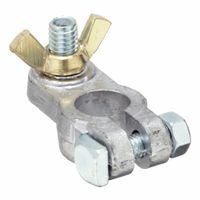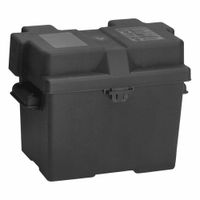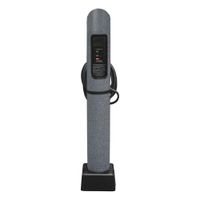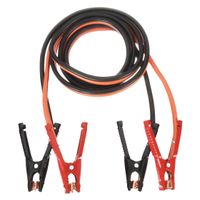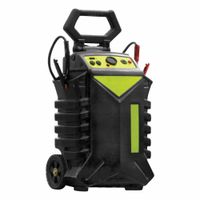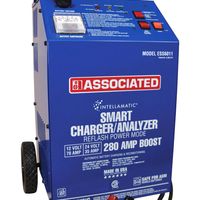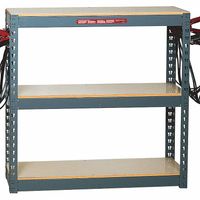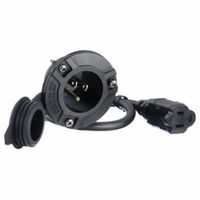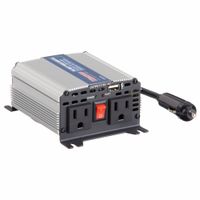Call +(254) 703 030 000 / 751 483 999 / 721 704 777
- Home
- Fleet Vehicle Maintenance
- Vehicle Electrical Battery Power Maintenance
- Vehicle Battery Power Charging
Vehicle Battery Power & Charging
Battery power and charging equipment helps connect, recharge, maintain, and jump-start vehicle batteries. Read Less
Frequently Asked Questions
How do I properly charge a car battery?
To properly charge a car battery, follow these steps:
1. **Safety First**: Wear safety goggles and gloves. Ensure the car is off, and the keys are removed. Work in a well-ventilated area to avoid inhaling any gases emitted by the battery.
2. **Inspect the Battery**: Check for any damage, leaks, or corrosion on the terminals. Clean the terminals with a mixture of baking soda and water if necessary, using a wire brush.
3. **Choose the Right Charger**: Use a charger compatible with your battery type (lead-acid, AGM, etc.). Ensure the charger voltage matches the battery (usually 12 volts for cars).
4. **Connect the Charger**:
- Attach the positive (red) clamp to the positive terminal of the battery.
- Attach the negative (black) clamp to the negative terminal. If the battery is still in the car, you can connect the negative clamp to an unpainted metal part of the car's frame to ground it.
5. **Set the Charger**: Adjust the charger settings according to the battery's specifications. For a slow charge, set it to a low amp setting (2-10 amps). A slow charge is generally better for the battery's longevity.
6. **Start Charging**: Plug in the charger and turn it on. Monitor the charging process. Most modern chargers will automatically stop when the battery is fully charged.
7. **Disconnect the Charger**: Once charged, turn off the charger and unplug it. Remove the negative clamp first, followed by the positive clamp.
8. **Final Check**: Reinstall the battery if it was removed. Ensure all connections are secure. Start the car to verify the battery is functioning properly.
9. **Maintenance**: Regularly check the battery's charge level and condition to prevent future issues.
What is the best battery charger for my vehicle?
The best battery charger for your vehicle depends on several factors, including the type of vehicle, battery specifications, and your specific needs. Here are some top considerations:
1. **Type of Battery**: Ensure the charger is compatible with your battery type, whether it's lead-acid, AGM, gel, or lithium-ion.
2. **Amperage**: Choose a charger with the appropriate amperage. A higher amperage charger will charge the battery faster. For regular maintenance, a 1-2 amp charger is sufficient, while a 10-30 amp charger is better for quick charging.
3. **Smart Chargers**: Opt for a smart charger with microprocessor control. These chargers automatically adjust the charge rate and prevent overcharging by switching to maintenance mode once the battery is fully charged.
4. **Voltage**: Ensure the charger matches your battery's voltage, typically 12V for most vehicles, but some may require 6V or 24V.
5. **Safety Features**: Look for chargers with safety features like reverse polarity protection, short circuit protection, and overcharge protection to prevent damage to the battery and ensure user safety.
6. **Portability and Ease of Use**: Consider a portable charger if you need to charge on the go. Also, look for user-friendly models with clear displays and simple controls.
7. **Brand and Reviews**: Choose reputable brands known for reliability and read customer reviews to gauge performance and durability.
Popular options include the NOCO Genius series, Battery Tender Plus, and CTEK MXS series, which are well-regarded for their smart charging capabilities, safety features, and ease of use. Always refer to your vehicle's manual for specific recommendations and consult with a professional if unsure.
How long does it take to charge a car battery?
The time it takes to charge a car battery depends on several factors, including the battery's capacity, the state of charge, the type of charger used, and the charging method.
1. **Battery Capacity and State of Charge**: Car batteries typically range from 40 to 80 amp-hours (Ah). If a battery is completely discharged, it will take longer to charge than one that is partially discharged.
2. **Charger Type**:
- **Trickle Chargers**: These are low-amperage chargers (1-2 amps) that can take 24 to 48 hours to fully charge a battery. They are ideal for maintaining a battery's charge over time.
- **Standard Chargers**: These chargers typically deliver 4 to 10 amps and can charge a battery in 4 to 12 hours, depending on the battery's capacity and state of charge.
- **Fast Chargers**: Delivering 20 amps or more, these can charge a battery in 1 to 3 hours. However, frequent use can reduce battery life.
3. **Charging Method**:
- **Conventional Charging**: Involves using a charger connected to a power outlet. The time varies based on the charger's amperage.
- **Alternator Charging**: When the car is running, the alternator charges the battery. This method is slower and depends on driving conditions and time.
4. **Battery Condition**: A new or well-maintained battery charges faster than an old or poorly maintained one.
5. **Temperature**: Cold temperatures can slow down the charging process, while moderate temperatures are optimal.
In summary, charging a car battery can take anywhere from 1 to 48 hours, depending on the factors mentioned above. For a quick charge, a fast charger is recommended, but for regular maintenance, a trickle charger is more suitable.
Can I use a trickle charger on my car battery?
Yes, you can use a trickle charger on your car battery. A trickle charger is designed to charge a battery slowly and maintain its charge over time, making it ideal for vehicles that are not used frequently. It provides a low, steady current to the battery, preventing it from discharging completely and extending its lifespan.
When using a trickle charger, ensure it is compatible with your car battery's voltage, typically 12 volts for most vehicles. Connect the charger to the battery terminals, ensuring the positive lead is attached to the positive terminal and the negative lead to the negative terminal. Some trickle chargers come with automatic shut-off features to prevent overcharging, which is beneficial for maintaining battery health.
Trickle chargers are particularly useful in cold climates where batteries are prone to losing charge or for vehicles stored for extended periods. They are also beneficial for maintaining the charge in classic cars, motorcycles, or any vehicle not driven regularly.
However, it's important to follow the manufacturer's instructions and safety precautions when using a trickle charger. Ensure the charger is placed on a stable surface and away from flammable materials. Regularly check the battery and charger to ensure they are functioning correctly.
In summary, a trickle charger is a practical tool for maintaining your car battery's charge, especially for infrequently used vehicles. It helps prevent battery discharge and prolongs battery life, making it a worthwhile investment for car owners.
How do I jump-start a car with a dead battery?
1. **Preparation**: Ensure both vehicles are turned off. Park the working car close to the car with the dead battery, but do not let them touch. Engage the parking brakes on both vehicles.
2. **Locate the Batteries**: Open the hoods and locate the batteries. Identify the positive (+) and negative (-) terminals on each battery.
3. **Connect Jumper Cables**:
- Attach one red clamp to the positive terminal of the dead battery.
- Attach the other red clamp to the positive terminal of the working battery.
- Attach one black clamp to the negative terminal of the working battery.
- Attach the other black clamp to an unpainted metal surface on the engine block or frame of the car with the dead battery. Do not connect it to the negative terminal of the dead battery.
4. **Start the Working Car**: Start the engine of the working car and let it run for a few minutes to charge the dead battery.
5. **Start the Dead Car**: Attempt to start the car with the dead battery. If it doesn’t start, wait a few more minutes and try again.
6. **Remove Jumper Cables**: Once the dead car starts, carefully remove the jumper cables in reverse order:
- Remove the black clamp from the metal surface on the dead car.
- Remove the black clamp from the negative terminal of the working battery.
- Remove the red clamp from the positive terminal of the working battery.
- Remove the red clamp from the positive terminal of the dead battery.
7. **Let the Engine Run**: Keep the engine of the revived car running for at least 15-30 minutes to allow the alternator to charge the battery.
8. **Drive the Car**: Consider driving the car for a while to ensure the battery is fully charged.
What is the difference between a battery maintainer and a charger?
A battery maintainer and a battery charger serve different purposes in managing battery health and performance.
A battery charger is designed to deliver a specific amount of current to a battery to replenish its charge. Chargers come in various types, such as trickle chargers, which provide a slow, steady charge, and fast chargers, which deliver a higher current for quicker charging. The primary function of a charger is to restore a battery to full capacity after it has been depleted. Chargers typically stop charging once the battery reaches full capacity, although some may not have this feature, potentially leading to overcharging if not monitored.
In contrast, a battery maintainer, also known as a battery tender or float charger, is designed to keep a battery at its optimal charge level over extended periods. Maintainers provide a low, steady current that compensates for the natural self-discharge of a battery, ensuring it remains fully charged without the risk of overcharging. They are ideal for vehicles or equipment that are not used regularly, such as seasonal vehicles, boats, or backup generators. Maintainers often have smart technology that monitors the battery's charge level and adjusts the current accordingly, maintaining the battery's health and longevity.
In summary, while a battery charger is used to recharge a depleted battery, a battery maintainer is used to keep a fully charged battery at its optimal level over time. Chargers are suitable for regular use when a battery needs recharging, whereas maintainers are best for long-term maintenance and storage.
How do I know if my battery charger is working properly?
To determine if your battery charger is working properly, follow these steps:
1. **Visual Inspection**: Check for any physical damage to the charger, cables, and connectors. Ensure there are no frayed wires or burnt smells.
2. **Indicator Lights**: Most chargers have LED indicators. A steady or blinking light often signifies charging, while a different color or pattern may indicate a full charge or an error. Refer to the charger's manual for specific meanings.
3. **Output Voltage**: Use a multimeter to measure the charger's output voltage. Compare this with the specifications on the charger's label. The voltage should be within the specified range.
4. **Charging Time**: Note the time it takes to charge the battery. If it takes significantly longer than usual, the charger may be faulty.
5. **Battery Performance**: After charging, check the battery's performance. If the battery discharges quickly or doesn't hold a charge, the charger might not be functioning correctly.
6. **Temperature Check**: During charging, the charger and battery should not overheat. Excessive heat can indicate a malfunction.
7. **Compatibility**: Ensure the charger is compatible with the battery type and capacity. Using an incompatible charger can lead to improper charging.
8. **Test with Another Battery**: If possible, test the charger with a different battery. If the second battery charges properly, the issue may be with the original battery.
9. **Test with Another Charger**: Use a different charger to charge the battery. If the battery charges correctly, the original charger may be faulty.
10. **Professional Testing**: If unsure, consult a professional technician to test the charger with specialized equipment.
By following these steps, you can assess whether your battery charger is functioning properly.
